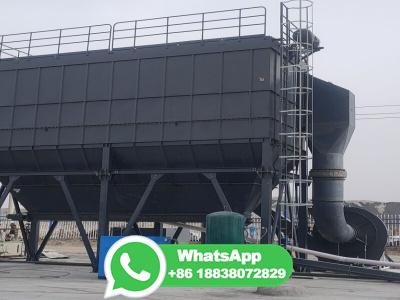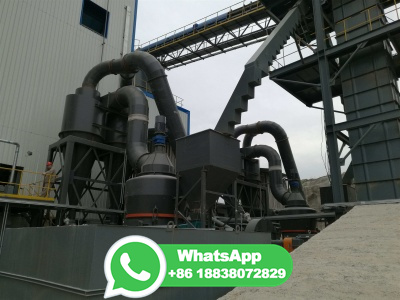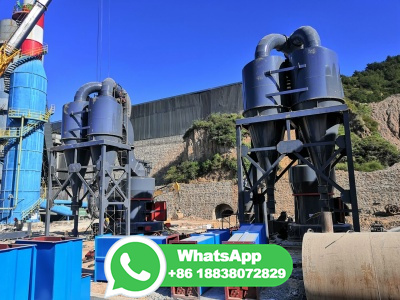
What does burning fossil fuels largely produce (2) Burning fossil fuels produces largely carbon dioxide and water vapor. For a given amount of energy, which fossil fuel produces the most CO2 and which produces the least. Coal produces the most CO2 and natural gas produces the least. How do we extract energy from fossil fuels (2)
WhatsApp: +86 18037808511
The process above describes the formation of natural gas in a traditional, conventional deposit. However, unconventional deposits such as tight gas, shale gas and coal bed methane are also sources of natural gas. In these deposits, natural gas is stored differently and is also more difficult to access than with traditional deposits. For further ...
WhatsApp: +86 18037808511
. They were formed over millions of years, from the remains of dead organisms: coal was formed from dead trees and other plant material crude oil and gas were formed from dead marine organisms...
WhatsApp: +86 18037808511
The formation of clastic and organic rocks begins with the weathering, or breaking down, of the exposed rock into small fragments. Through the process of erosion, these fragments are removed from their source and transported by wind, water, ice, or biological activity to a ... Sedimentary rocks like bituminous coal, limestone, and sandstone, ...
WhatsApp: +86 18037808511
Natural gas is a fossil other fossil fuels such as coal and oil, natural gas forms from the plants, animals, and microorganisms that lived millions of years ago. There are several different theories to explain how fossil fuels are formed. The most prevalent theory is that they form underground, under intense conditions. As plants, animals, and microorganisms decompose, they are ...
WhatsApp: +86 18037808511
Coal is a black or brownishblack sedimentary rock that can be burned for fuel and used to generate is composed mostly of carbon and hydrocarbons, which contain energy that can be released through combustion (burning). Coal is the largest source of energy for generating electricity in the world, and the most abundant fossil fuel in the United States.
WhatsApp: +86 18037808511
Procedure 1. Introduce or review physical properties of rocks and minerals, such as luster, hardness, cleavage/fracture, color, etc. 2. Pass around samples of the different types of coal, if you ...
WhatsApp: +86 18037808511
Coal is a black sedimentary rock. It usually occurs in coal beds found in coal mines. Coal comprises of carbon, hydrogen, oxygen, sulphur, etc. When dead plants and animals decay and convert into peat which in turn is converted into lignite, then subbituminous coal, after that bituminous coal, and lastly anthracite. Hence, coal is a fossil fuel.
WhatsApp: +86 18037808511
1) Formation in Earth's Mantle. Geologists believe that the diamonds in all of Earth's commercial diamond deposits were formed in the mantle and delivered to the surface by deepsource volcanic eruptions. These eruptions produce the kimberlite and lamproite pipes that are sought after by diamond prospectors. Most of these pipes do not contain ...
WhatsApp: +86 18037808511
Coal is a nonclastic sedimentary rock. They are the fossilized remains of plants and are in flammable black and brownishblack tones. Its main element is carbon, but it can also contain different elements such as hydrogen, sulfur and oxygen. Unlike coal minerals, it does not have a fixed chemical composition and crystal structure.
WhatsApp: +86 18037808511
Formation of Coal. Coalification is a process in which dead matters like plants and vegetation convert into coal over a prolonged period of time. In the past geological times, the Earth was covered with dense forests, especially in the wetland areas. ... Yes, coal is a natural resource as it is generated from the dead and decayed vegetation and ...
WhatsApp: +86 18037808511
The process of formation of coal is known as coalification. The dense forest present in the lowlying wetland got buried in the earth, millions of years ago. Soil kept depositing over them and they got compressed. As they went deeper and deeper, they faced high temperature and pressure. As a result, the substances slowly got converted into coal.
WhatsApp: +86 18037808511
Petroleum is a mixture of many substances such as gas, petrol, diesel, kerosene, lubricating oil, paraffin wax, etc. As these constituents serve different purposes, it is important to separate them, or in other words, refine the crude oil. This process of separation of various constituents of petroleum is called petroleum refining.
WhatsApp: +86 18037808511
coal, Solid, usually black but sometimes brown, carbonrich material that occurs in stratified sedimentary of the most important fossil fuels, it is found in many parts of the world. Coal is formed by heat and pressure over millions of years on vegetation deposited in ancient shallow swamps (see peat).It varies in density, porosity, hardness, and reflectivity.
WhatsApp: +86 18037808511
Other articles where coal processing is discussed: coal mining: Coal preparation: As explained above, during the formation of coal and subsequent geologic activities, a coal seam may acquire mineral matter, veins of clay, bands of rock, and igneous intrusions. In addition, during the process of mining, a portion of the roof and floor material.
WhatsApp: +86 18037808511
Question 8: Explain the process of formation of petroleum. Answer: Petroleum is formed by the burial of aquatic plants and animals below the sea bed. The marine animals and plants died thousands of years ago and settled down in the bottom of the sea. In anaerobic conditions, microorganisms decompose this organic matter.
WhatsApp: +86 18037808511
Coal is an abundant natural resource that can be used as a source of energy, as a chemical source from which numerous synthetic compounds (, dyes, oils, waxes, pharmaceuticals, and pesticides) can be derived, and in the production of coke for metallurgical processes. Coal is a major source of energy in the production of electrical power ...
WhatsApp: +86 18037808511
Most coal has some methane (the main component of natural gas) trapped inside it. This methane is produced during the coal formation process and gets trapped on the surface of the coal in tiny pores and fractures. 1 Many coalbeds also contain large amounts of water; the pressure from this water keeps the methane in place. Coalbed methane is extracted by pumping out the water, which lowers the ...
WhatsApp: +86 18037808511
Fossil fuel formation refers to the process that takes place over the time span of hundreds of millions of years to produce a variety of fossil fuels including coal, oil, and natural all of the produced materials begin as organic material and are transformed over a large time span due to burial by sediment, pressure, and temperature, different conditions result in the formation of ...
WhatsApp: +86 18037808511
The uses of fractional distillation are that it enables component separation into different phases and purification of organic compounds. In coal and petroleum class 8 notes, the classification of natural resources, the formation of petroleum and coal and the refining of petroleum along with class 8 Science chapter 5 MCQs are discussed.
WhatsApp: +86 18037808511
The formation of peat is the first step in the formation of coal. With increasing depth of burial and increasing temperature, peat deposits are gradually changed to lignite. With increased time and higher temperatures, these lowrank coals are gradually converted to subbituminous and bituminous coal and under certain conditions to anthracite.
WhatsApp: +86 18037808511
Without human interference, the carbon in fossil fuels would leak slowly into the atmosphere through volcanic activity over millions of years in the slow carbon cycle. By burning coal, oil, and natural gas, we accelerate the process, releasing vast amounts of carbon (carbon that took millions of years to accumulate) into the atmosphere every year.
WhatsApp: +86 18037808511
The term "fossil fuel" applies to organic material deposits that can burn, thus producing energy. One such fuel is coal, which is the solid altered remains of plant material, while oil and gas are the liquid and gaseous remains of various organic or inorganic sources. Standard thinking requires long ages for their origin. For decades it has been taught that dead plants accumulate in the ...
WhatsApp: +86 18037808511
Plankton decomposes into natural gas and oil, while plants become coal. Today, humans extract these resources through coal mining and the drilling of oil and gas wells on land and offshore. They are sought after because they contain stored energy, and when burned, fossil fuels power machinery and provide transportation, as well as the ...
WhatsApp: +86 18037808511
Answer: When coal is heated without air, it does not burn but produces many byproducts. This process of heating coal in the absence of air is called destructive distillation of coal. The main products formed by this process are: coke coal tar amino acid liquor coal gas The destructive distillation of coal can be carried out in the laboratory.
WhatsApp: +86 18037808511
Petroleum, also known as crude oil, or simply oil, is a naturally occurring yellowishblack liquid mixture of mainly hydrocarbons, and is found in geological name petroleum covers both naturally occurring unprocessed crude oil and petroleum products that consist of refined crude oil.. Petroleum is primarily recovered by oil drilling. ...
WhatsApp: +86 18037808511
1 The History of CBM. Coal Bed Methane is primarily the methane gas which is evolved during the formation of coal from the woody matter of plant origin. The gas is observed to get adsorbed on the surface of the coal. Production of coalbed methane (CBM) has become an important source of fuel providing a nonpolluting fuel in an era focused on ...
WhatsApp: +86 18037808511
It takes millions of years to create and as a nonrenewable resource, there is only a finite amount.
WhatsApp: +86 18037808511
In the process of coal formation, first, the hydrogen is removed, then the nitrogen, and then the carbon. Carbon is most stable amongst hydrogen, nitrogen, and carbon. When the biochemical decomposition of vegetal matter happens, the result is carbon enrichment. Mode of Deposition of Coal. Let us understand the process of coal deposition in detail.
WhatsApp: +86 18037808511
Coals are obtained by natural 300 million years ago the earth had dense forests in low lying wetland to natural processes,like flooding, these forests buried under soil deposited over them they were compressed.
WhatsApp: +86 18037808511
There are two main phases in coal formation: peatification and coalification. Bacterial activity is the main process that creates the peat during peatification. Increasing temperature and pressure from burial are the main factors in coalification. [2] To form coal, the following steps are followed (Figure 2 illustrates these steps): [5] [6]
WhatsApp: +86 18037808511
The process that microbes use to create a methane precursor molecule from coal. Anaerobic microbes live in the pore spaces between coal. They produce enzymes that they excrete into the pore space ...
WhatsApp: +86 18037808511
Fossil fuels are made from decomposing plants and animals. These fuels are found in Earth's crust and contain carbon and hydrogen, which can be burned for energy. Coal, oil, and natural gas are examples of fossil fuels. Coal is a material usually found in sedimentary rock deposits where rock and dead plant and animal matter are piled up in layers. More than 50 percent of a piece of coal's ...
WhatsApp: +86 18037808511
Although peat is used as a source of energy, it is not usually considered a is the precursor material from which coals are derived, and the process by which peat is formed is studied in existing swamps in many parts of the world (, in the Okefenokee Swamp of Georgia,, and along the southwestern coast of New Guinea).The formation of peat is controlled by several factors ...
WhatsApp: +86 18037808511